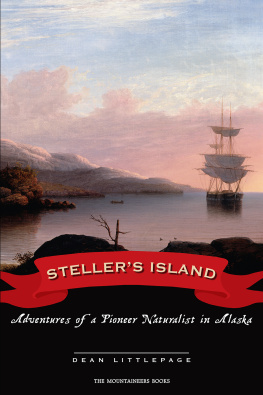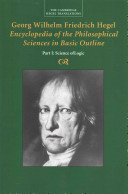Praise for the nature classic Where the Sea Breaks Its Back:
In the history of maritime discovery, few voyages can match the obstacles, hardships and success of Berings Second Expedition in 1741, that initial crossing of the North Pacific. Where the Sea Breaks Its Back tells the heroic and tragic story of that momentous expedition. The books hero is not Vitus Bering, the commander who died at the moment before success, but Georg Wilhelm Steller, the brilliant German-born scientist, naturalist, botanist and physician who accompanied Bering.
Corey Ford skillfully unfolds Stellers complex, contradictory nature and the significance of the events in which he figured....The book...will appeal...to all who want a true story well told.
The New York Times
While essentially the book is a testament to the human spirit, Fords concern for the lesser creatures, the unique wildlife in this part of the world, runs as an enlightening and important undercurrent.
Chicago Tribune
[The chapter called] The Plunderersthe horrifying account of the near-extinction of the sea otter by Russian fur traders in the mid-eighteenth century in the Aleutian Islands, and later measures taken to save the animals[is] a classic story of conservation.
Field & Stream
Where the Sea Breaks Its Back is more than a thrilling adventure story. It is a vivid word picture of Alaskas pioneer naturalist, and of the strange birds and beasts of the sea which he observed in the fogbound and mysterious Aleutian chain. Here is a solid contribution to American natural history....
from the Introduction by Frank Dufresne,
former Director, Alaska Game Commission

Where the Sea Breaks
Its Back
The Epic Story of Early Naturalist Georg Steller
and the Russian Exploration of Alaska
by COREY FORD
With drawings by L OIS D ARLING
ALASKA NORTHWEST BOOKS
Copyright 1966 by Corey Ford
First Alaska Northwest Books printing: 1992
All rights reserved. No part of this book may be reproduced or transmitted in any form or by any means, electronic or mechanical, including photocopying, recording, or by any information storage and retrieval system, without written permission of Alaska Northwest Books.
Library of Congress Cataloging-in-Publication Data
Ford, Corey, 1902-1969
Where the sea breaks its back: the epic story of early naturalist Georg Steller and the Russian exploration of Alaska / by Corey Ford: With drawings by Lois Darling.
p. cm.
Originally published: Boston: Little, Brown, 1966.
Includes bibliographical references.
ISBN-13: 978-0-88240-394-6
1. Steller, Georg Wilhelm, 17091746JourneysAlaska. 2. Kamchatskaia exspeditsha (2nd: 17331743). 3. RussiansAlaskaHistory18th century. 4. alaskadiscovery and exploration18th century. 5. NaturalistsGermany Bibliography. I. Title.
QH31.S65F6 1992
508.798092dc20
[b]
92-3387
CIP
Where the Sea Breaks Its Back was first published in 1966 by Little, Brown and Company, in Boston and simultaneously in Toronto, Canada. The text of the 1992 edition was published by arrangement with Harold Ober Associates, Inc., New York. Original illustrations by Lois Darling were published by arrangement with Little, Brown and Company.
Front cover, 19th-century engraving:
Vitus Bering Discovers Alaska and Perishes in Ice-Bound Seas
Courtesy the Bettmann Archive
Cover design by Vicki Knapton
Alaska Northwest Books
An imprint of Graphic Arts Books
P.O. Box 56118
Portland, OR 97238-6118
(503) 254-5591
www.graphicartsbooks.com
In Memory of
Frank Dufresne


Introduction
Georg Wilhelm Steller was one of the strangest and most fascinating characters ever to appear on the western scene. He was brilliant; he was arrogant; he was gifted as are few men. Though he spent no more than ten hours on Alaskan soil, his accomplishments in that short day were such that his name will live forever. There is nothing comparable to his deeds nor to Steller, the man in all our history.
He was naturalist, botanist, physician. All three professions played important parts in his meteoric career. As a naturalist, on Vitus Berings historic voyage to Alaska in 1741, he discovered the Stellers Jay, the Stellers Eider, the rare Stellers Eagle, and the now legendary Stellers White Raven. Turning to the ocean, he found and recorded the Stellers Greenling, our brilliantly colored rock trout. His is the only description of the giant northern manatee called Stellers Sea Cow, which became totally extinct shortly afterward. Stranger still is his detailed report of a creature never again seen by man: Stellers Sea Monkey, which lives only in this young Germans vivid field notes. Stellers Hill on Kayak Island, Stellers Mountain, and Stellers Arch are visible monuments to the first white man ever to set foot in northwest America, the first naturalist to describe the flora and fauna of the new world.
As a botanist, Georg Wilhelm Steller collected and classified scores of hitherto unknown plants. It was his knowledge of their antiscorbutic value, combined with his devoted skill as a physician, which saved the lives of his Russian shipmates as they lay dying beside their wrecked vessel on a lonely island in Bering Sea. Though he professed only contempt for these ignorant sailors, and castigated them pitilessly aboard ship, he tended them like babies when they cried out for help.
Steller, the man, was so complex as to defy analysis. You could hate him, you could love him, but you could never understand him. The writer who has come closest to bringing back a living Steller for you to meet, and judge for yourself, is Corey Ford.
Two hundred years after Georg Steller, almost to the day, Corey Ford himself a highly qualified naturalist and historian sailed the stormy waters of the North Pacific on a course remarkably coincidental with that of Berings ill-fated St. Peter. He visited the same Aleutian Islands, saw the same birds and mammals, and experienced the same violent gales and fog in a remote region which has altered but little in two centuries. With Stellers own journal in his hands, Corey Ford compared, caught fire, became fascinated. This book is the result.
Where the Sea Breaks Its Back is more than a thrilling adventure story. It is a vivid word picture of Alaskas pioneer naturalist, and of the strange birds and beasts of the sea which he observed in the fogbound and mysterious Aleutian chain. Here is a solid contribution to American natural history, as well as an important restoration of our nations neglected past.
F RANK D UFRESNE
Former Director,
Alaska Game Commission
Contents
Part One: VOLCANOES, MUMMIES, SEA
OTTERS
PART ONE
Volcanoes, Mummies,
Sea Otters












